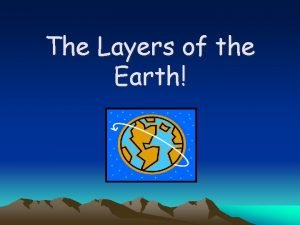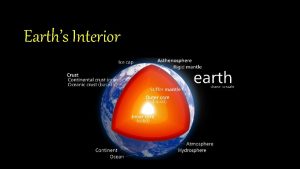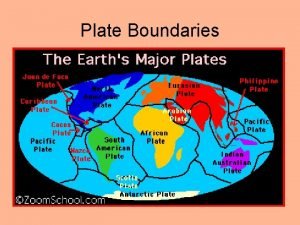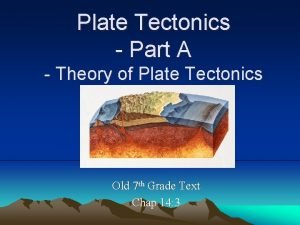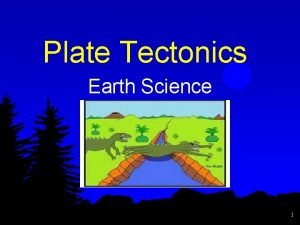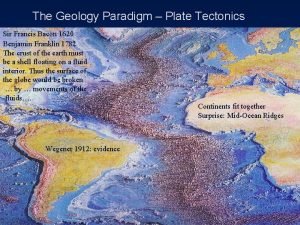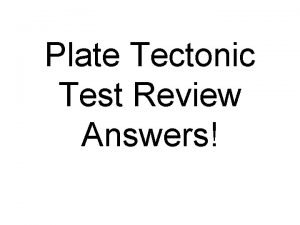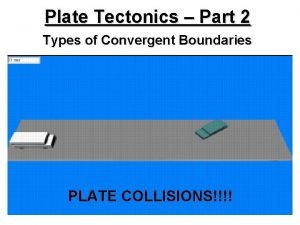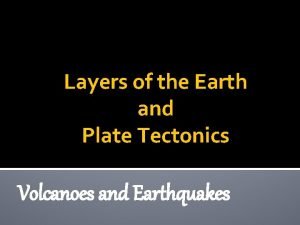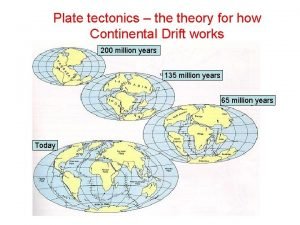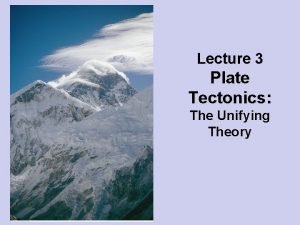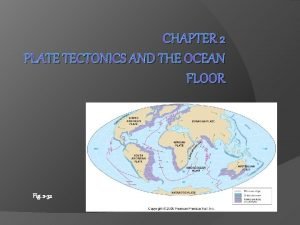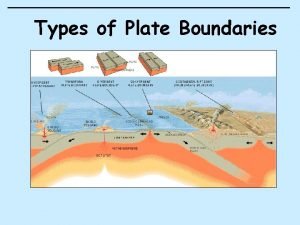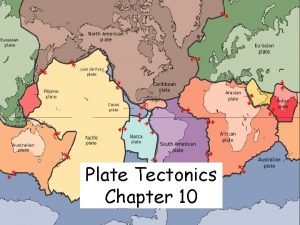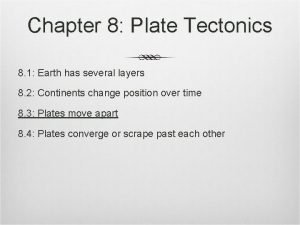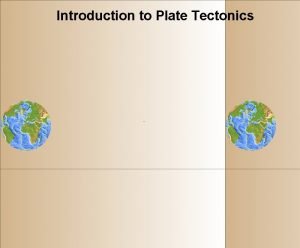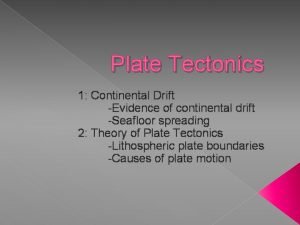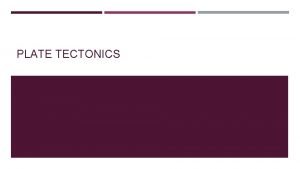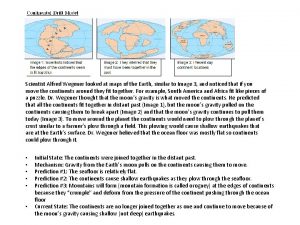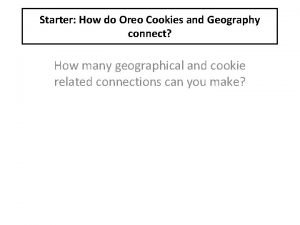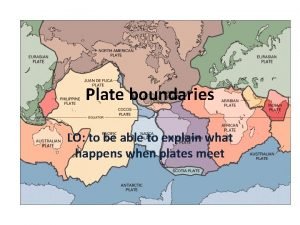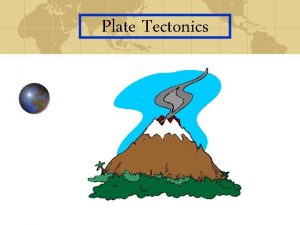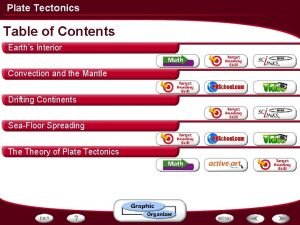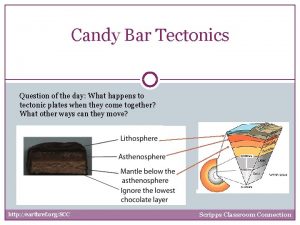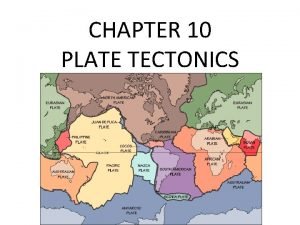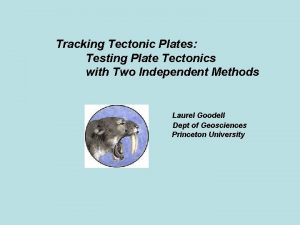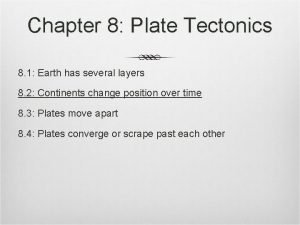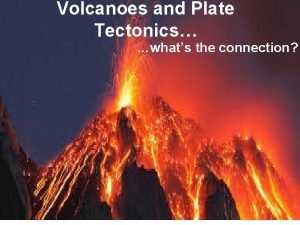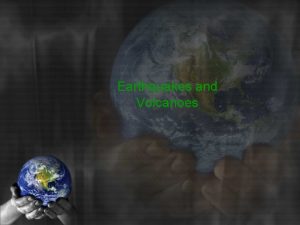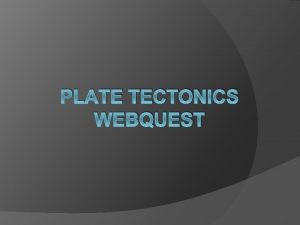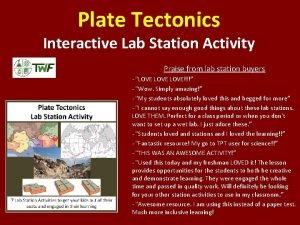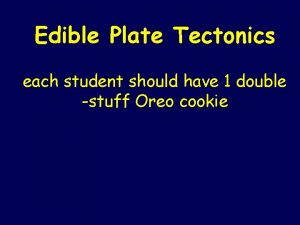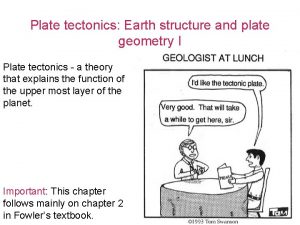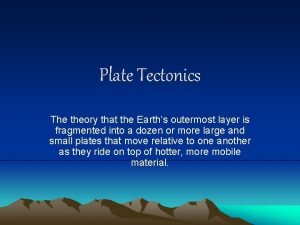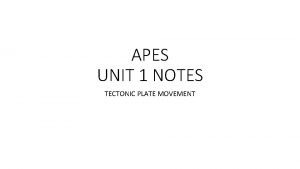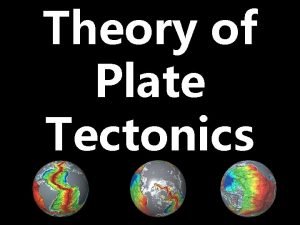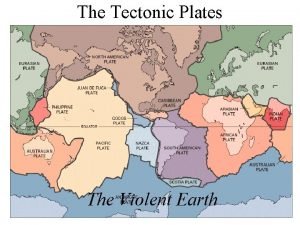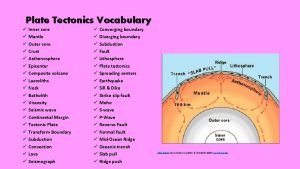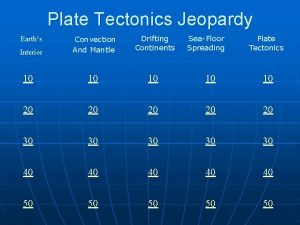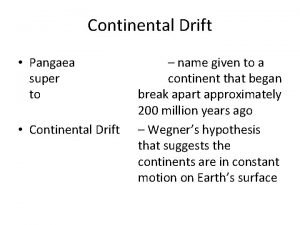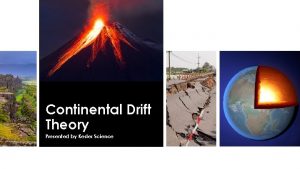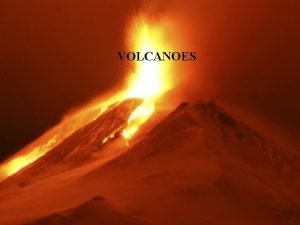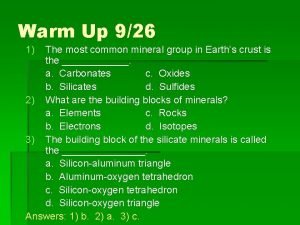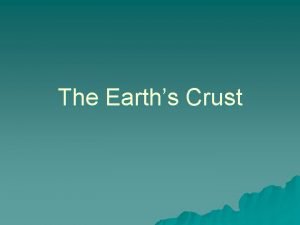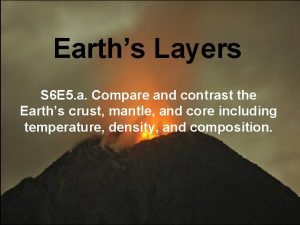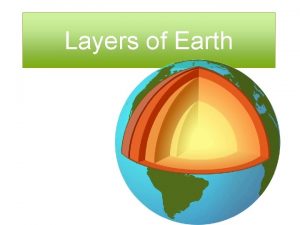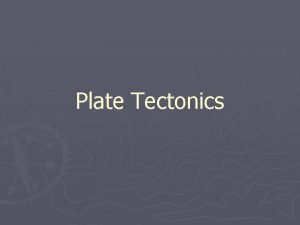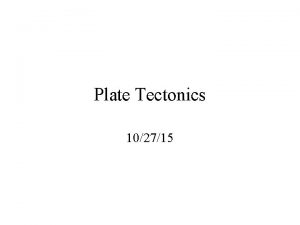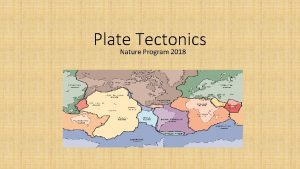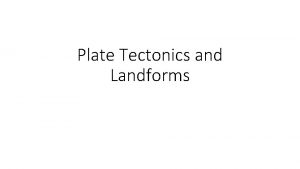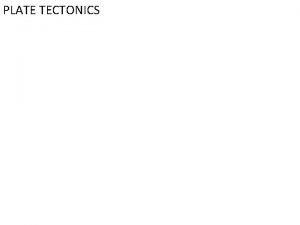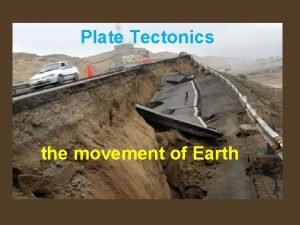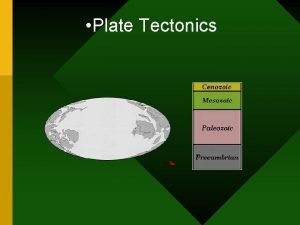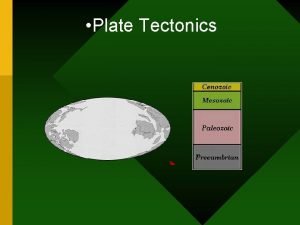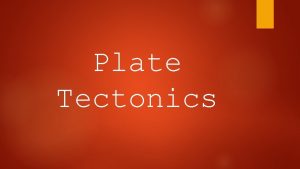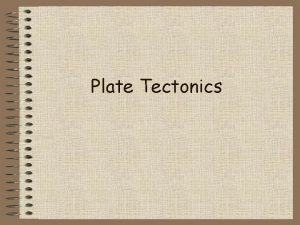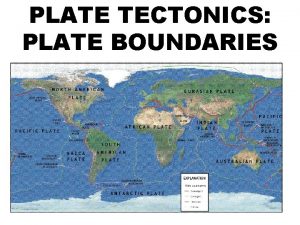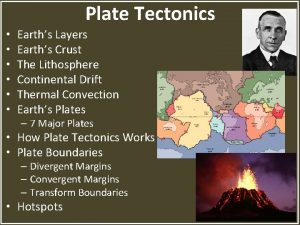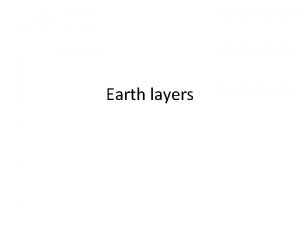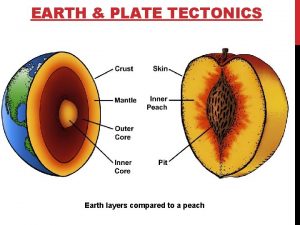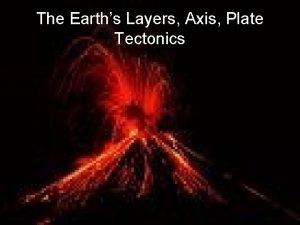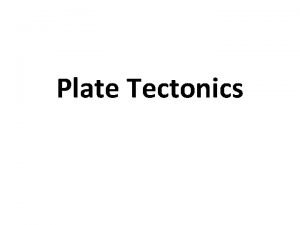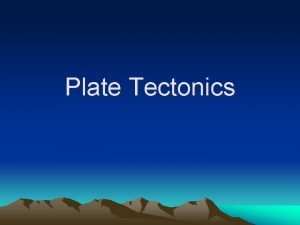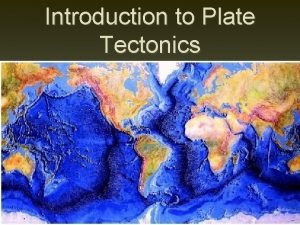Plate Tectonics 101414 Layers of the Earth Crust




















































- Slides: 52

Plate Tectonics 10/14/14

Layers of the Earth Crust- Mantle- Rigid, rocky outer surface of Earth Oceanic crustbasalt Continental crust- granite -crust is thinner under oceans and thicker under Rocky layer located 1. Outer core -Liquid layer made of Iron under the crust -composed of Si, O, and Nickel 2. Inner core- center Mg, Fe, and Al. of Earth- It is -convection currents carry heat Solid (Fe & Ni), extremely hot and inner mantle to under great pressure upper mantle continents Core-


-The movement of the plates is caused by convection currents deep in the Earth. -Magma rises and sinks due to differences in density.

DO NOW: Explain how a lava lamp works and what Process is this? In what layer of the Earth does this happen?



Use page 3 of workbook to answer these questions: • 1. At what depth does the inner core start? • 2. Which layer would have material with a density of 5. 3 g/cm 3? • 3. What is the pressure at 4, 000 km? • 4. At approximately what depth is the internal temperature of the earth thought to be 2000 K?


Theory of Continental Drift: Proposed by Alfred Wegener. The idea that states that continents were once a giant landmass, and broke into pieces that moved to the position they are in today.


Evidence that supports Continental Drift Theory 1. The continents look like they fit together like a giant puzzle 1. 2. 2. Fossil evidence: Fossils of the same plants and animals have been found on different continents. (Example the mesosaurus in both Africa and South America. )

More fossil evidence

3. Fossils of tropical plants and crocodiles found in Canada. 4. The age and types of rocks and minerals on one continent seem to match those on other continents. 5. Mountain chains in North America match up with mountain chains in Europe.

DO NOW: 1. Locate South America and Africa on the map above. How are they moving in relationship to each other? 2. Locate North America. How is North America Moving in relation to the equator? 3. How do you think this movement affected the climate of North America? 4. How would the movement of these continents affect the Atlantic Ocean?

Direct evidence of crustal movement (we see today) • Earthquakes • Volcanoes • Satellite images that measure the movement of the crust. Approximately 5 cm per year

• Indirect evidence of crustal movement Folding • Faulting

• Terrace • Fossils found high on mountain tops


The next Pangea, "Pangea Ultima" will form as a result of the subduction of the ocean floor of the North and South Atlantic beneath eastern North America and South America. This supercontinent will have a small ocean basin trapped at its center.

Theory of Plate tectonics • Theory based on continental drift – Crust and rigid mantle consist of about 12 slabs of solid rock called lithospheric plates ( Plates move continuously, but at various speeds and in different directions) - Plates move because of convection currents – Movement causes, mountain building, volcanic activity and earthquakes. • Fault- a crack or fracture in the earth’s crust

-The movement of the plates is caused by convection currents deep in the Earth. -Magma rises and sinks due to differences in density.

Faults and Plate boundaries Type of fault Description Boundary Type Compression Plates push together Normal- Plates pull apart Divergent Reverse- Convergent tension Strike-slip - Plates slide past Transform Shearing each other

At what plate boundary does 1 occur? 2? 3? 4?

Notice the different plates can be moving together or apart

Convergent Continental v. Continental

Convergent. Oceanic v. Continental Trench forms At boundary More dense plate (oceanic) sinks Below the less Dense plate (continental) Mountains and volcanoes form

Divergent Oceanic v. Oceanic Seafloor spreading is when 2 oceanic plates move apart

Normal fault • normal fault- occurs where the crust is being pulled apart, due to the pull of a divergent plate boundary.

Reverse fault • Reverse fault - forms where a plate is being compressed at a Convergent plate boundary.

Strike-slip fault strike-slip fault- the rock moves in opposite horizontal directions. These form when the crust pieces are sliding against each other, as in a transform plate boundary



What kind of fault is this? Plate boundary? What kind of changes do you see? What direction does it go?

How earthquakes work

San Andreas Fault • The San Andreas fault zone slices through two thirds of the length of California. Along it, the Pacific Plate has been grinding horizontally past the North American Plate for 10 million years, at an average rate of about 5 cm/yr. Land on the west side of the fault zone (on the Pacific Plate) is moving in a northwesterly direction relative to the land on the east side of the fault zone (on the North American Plate).



On what plate is A? B? On what plate boundary is C? D? C A D B

DO NOW: On what plate is X? What plate boundary is at the blue X? What happens to that plate when it meets another plate? (be specific) Where are the majority of earthquakes and volcanoes?

Definitions • Earthquake- a strong, sudden movement of the earth’s crust • Focus- where the earthquake starts inside the earth • Epicenter- place on surface of the earth above focus-where it shakes the hardest • Seismic waves- earthquake waves • Seismograph- instrument that measures and detects earthquakes • Tsunami- caused by an undersea earthquake


Type of wave Name P-wave Speed Motion Moves through Primary or compressional wave Back and forth Solids, liquids, gases S-wave Secondary or shear wave Side to side Solids only L-wave Surface wave Like ocean surface waves

Pwave S-wave

What time does the p-wave arrive? S-wave? Seismogram reading using a seismograph

Time math is used because P and S waves arrive at different times Time math works almost the same way except instead of taking over ten from the neighboring column you’ll take one minute and convert it into 60 seconds. 3: 13: 25 (“ 3 hours, 13 minutes, and 25 seconds”) -1: 09: 37 turns into: 3: 12: 85 (3 hrs, 12 min, 85 secs is the same as 13: 25) -1: 09: 37 2: 03: 48 http: //www. mrsciguy. com/eq. html




Notice at each Plate boundary there are earthquakes. Where are they the deepest? Shallowest? Indicate letter and type of plate Boundary.


 Earth crust layers
Earth crust layers Layers of earth crust
Layers of earth crust Future plate tectonics
Future plate tectonics Driving force of plate tectonics
Driving force of plate tectonics Plate tectonics
Plate tectonics Francis bacon plate tectonics
Francis bacon plate tectonics Continental drift vs plate tectonics theory
Continental drift vs plate tectonics theory Mantle magma
Mantle magma Boundaries of plate tectonics
Boundaries of plate tectonics Throw your hands up for the layers of the earth
Throw your hands up for the layers of the earth Rodinia
Rodinia Unifying theory of plate tectonics
Unifying theory of plate tectonics From now
From now Convergent boundary with subduction
Convergent boundary with subduction Summarize the theory of plate tectonics
Summarize the theory of plate tectonics Chapter 8 plate tectonics
Chapter 8 plate tectonics Theory of plate tectonics
Theory of plate tectonics Plate tectonics
Plate tectonics Plate boundaries
Plate boundaries Compare continental drift and plate tectonics
Compare continental drift and plate tectonics Oreo cookies and plate tectonics answers
Oreo cookies and plate tectonics answers Plate tectonic boundaries
Plate tectonic boundaries Juan de fuca plate
Juan de fuca plate Seafloor spreading material at trenches
Seafloor spreading material at trenches Candy bar tectonics
Candy bar tectonics Chapter 10 plate tectonics
Chapter 10 plate tectonics Plate motion calculator
Plate motion calculator Harry hess and seafloor spreading
Harry hess and seafloor spreading Chapter 8 plate tectonics
Chapter 8 plate tectonics Plate tectonics
Plate tectonics Plate tectonics
Plate tectonics Plate tectonics webquest
Plate tectonics webquest Types of volcanoes
Types of volcanoes Plate tectonics interactive lab
Plate tectonics interactive lab Divergent boundary oreo
Divergent boundary oreo Layers of the earth jeopardy
Layers of the earth jeopardy Plate tectonics
Plate tectonics Plate tectonics definition
Plate tectonics definition Plate tectonics
Plate tectonics Plate boundaries apes
Plate boundaries apes The plate tectonics theory states that
The plate tectonics theory states that Plate tectonics vs continental drift
Plate tectonics vs continental drift San andreas fault map
San andreas fault map Plate tectonics vocabulary worksheet
Plate tectonics vocabulary worksheet Plate tectonics game board
Plate tectonics game board Convergent plate boundary
Convergent plate boundary Pangaea
Pangaea Plate tectonics vs continental drift
Plate tectonics vs continental drift Kesler science plate tectonics
Kesler science plate tectonics An opening on the earth's crust where lava exits
An opening on the earth's crust where lava exits Most abundant minerals in earth's crust
Most abundant minerals in earth's crust Vibrations on the earth's crust
Vibrations on the earth's crust Crust mantle core
Crust mantle core
